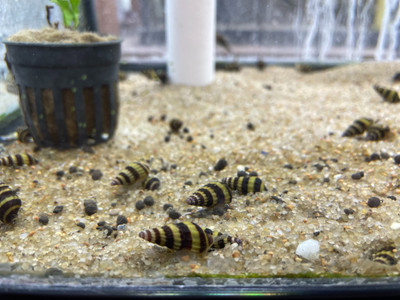Sunday Species Spotlight: Assassin Snail (Antentome helena)
Posted by Crystal Chan on on 20th Aug 2022
Assassin Snail (Antentome helena)
IUCN Conservation Status: Not rated
Ecology
As one of the few freshwater species in the family Nassariidae, this snail is an extremely active scavenger and hunter that hails from tropical streams, rivers, and lakes in Southeast Asia. [1] Not much is known about this species in the wild, so most knowledge about this species comes from aquarium observations. As the name suggests, the Assassin Snail is known to attack and eat other snails. It does so by using its proboscis to track down its prey, then using its foot to grab its victim while it stabs the snail with a forked appendage to feed. [2] This snail is considered a generalist* predator, and is known to attack many types of snails as well as scavenge decaying animal matter (like bloodworms and dying fish). [4] This snail also reproduces easily, laying small white eggs that look similar to those of nerites. [2] It has also been found to carry trematode parasites commonly found on snails. [3]
Fishery
Although this snail breeds easily, most sources are wild-caught, and there is not much information about fishing activities negatively affecting this species’ population. There have been some reports about this snail being introduced to areas outside of its native range, but as of now there have not been enough reports to indicate it causing damage to ecosystems outside of its natural habitat. [5]
In Aquaria
Having been introduced to the aquarium hobby a few years ago, this snail has become a popular way of keeping pest snail populations under control! However, it is important to note that this snail is capable of killing and eating all aquarium snails–even decorative snails like nerites and mystery snails. As such, make sure to avoid keeping Assassin snails in tanks with snails you plan on keeping. This snail also needs warmer water to survive as it comes from the tropics. It can also be fed with frozen or live worms instead of snails.
*generalist: an animal that eats a variety of things compared to specialists, which eat very specific diets
Citation
[1] Clea helena (assassin snail). (2019). CABI Invasive Species Compedium. https://www.cabi.org/isc/datasheet/108187
[2] O’Leary, R. (2015). The Assassin snail, Clea helena-Species Spotlight - YouTube.
[3] Chomchoei, N., Backeljau, T., Segers, B., Wongsawad, C., Butboonchoo, P., & Nantarat, N. (2022). Morphological and molecular characterization of larval trematodes infecting the assassin snail genus Anentome in Thailand. Journal of Helminthology, 96, E52. doi:10.1017/S0022149X22000463
[4] Berkhout, B. W., & Morozov, A. (2022). Assassin snails (Anentome helena) as a biological model for exploring the effects of individual specialisation within generalist predators. PLoS ONE, 17(3 March), 1–19. https://doi.org/10.1371/journal.pone.0264996
[5] Ng, T. H., Foon, J. K., Tan, S. K., Chan, M. K. K., & Yeo, D. C. J. (2016). First non-native establishment of the carnivorous assassin snail, Anentome helena (von dem Busch in Philippi, 1847). BioInvasions Records, 5(3), 143–148. https://doi.org/10.3391/bir.2016.5.3.04

